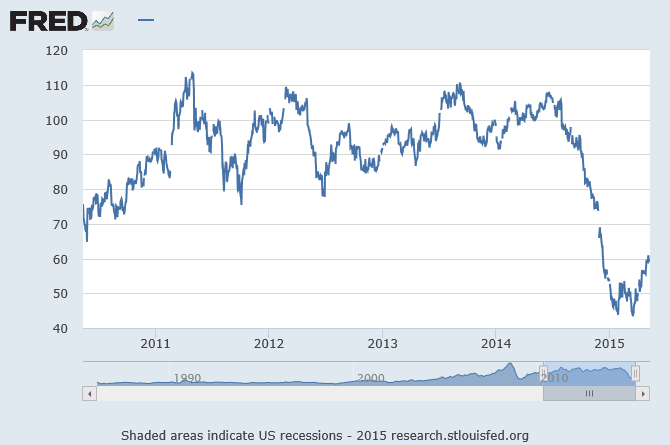|
|






| |

May 2015 SEE Monthly Update -
Investor Momentum, Oklahoma Earthquakes, Bakken Rail Transport

Graph of crude oil prices. Vertical axis is $/barrel for West Texas Intermediate at Cushing
Investors looking for returns on all types of assets—securities, debt, real estate, and commodities—are rolling back into oil producers' securities at a rate that suggests belief (or hope) in a longer-term higher price. Each day brings a new debate about incremental oil demand, relative strength or weakness of the dollar, Mideast turmoil, the upcoming U.S. driving season, crude oil inventory as a leading indicator, Tesla battery advances, the size of U.S. reserves (how many barrels at $50/bbl vs. how many at $90/bbl), the steepness of the oil decline rates from unconventional wells, potential new volumes from the overhang of drilled but uncompleted (DUC) wells, and water recycling vs. deep wastewater disposal wells.
Per the U.S. Energy Information Administration (EIA), domestic shale oil production is predicted to fall 54,000 barrels per day (BPD) in May and 86,000 BPD in June. While the May figure represents 0.6% of the 9 million BPD of current production, oil is being priced on the margin. Both OPEC and the EIA are also forecasting slightly increased demand.
While not all deep wastewater disposal wells are a factor in the spate of new seismicity—see, for example, the Permian—Texas and Oklahoma have started more aggressively monitoring faults and shutting down deep disposal wells drilled in areas that have and are experiencing earthquakes. Oklahoma has shut down at least fifty such disposal wells. According to PennEnergy, a group of environmental and local organizations are calling for a moratorium on deep wastewater disposal wells in areas where they may trigger earthquakes in sixteen Oklahoma counties. Mild as it appears, this is unusual activism in a state for which oil and gas production is a key economic driver.
After the Amtrak passenger train derailment in Philadelphia, even more regulatory and safety emphasis can be expected for both passenger and freight trains.
Oil train derailments specifically have generated concern, in part because trains travel through densely-populated areas. While pipelines are cheaper and many times safer, the lack of pipeline capacity for North Dakota oil contrasts to the immediate availability and destination flexibility of crude-by-rail (CBR) to all parts of the country. In fact, according to the EIA, in February more than half of the east coast's crude oil—which comes from the U.S. and Canada--was delivered by rail.
For more on this topic log in now or, if you are not already a subscriber, subscribe now.
Copyright 2015, Starks Energy Economics, LLC. This information is confidential and is intended only for the individual named. This information may not be disclosed, copied or disseminated, in whole or in part, without the prior written permission of Starks Energy Economics, LLC. This communication is based on information which Starks Energy Economics, LLC believes is reliable. However, Starks Energy Economics, LLC does not represent or warrant its accuracy. This communication should not be considered as an offer or solicitation to buy or sell any securities.
I, Laura Starks, do hereby certify that, to the best of my knowledge, the views and opinions in this research report accurately reflect my personal views about the companies and their securities as of the date of this report. These viewpoints and opinions may be subject to change without notice and Starks Energy Economics, LLC will not be responsible for any consequences associated with reliance on any statement or opinion contained in this communication. No Starks Energy Economics, LLC consultant or analyst has nor will receive direct or indirect compensation in return for expressing specific recommendations or viewpoints in this report.

- Regulatory Changes, Earthquakes, and Proppant Companies - April 2015
- Oil Field Services Stress Tested - February 2015
- Haynesville, Louisiana Dry Natural Gas Field - January 2015
- Is the Permian a Bargain Basin Yet? - December 2014
- Starks Energy Economics on Natural Gas - 4th quarter 2014
- Eagle Ford Energy - 3rd quarter 2014
- The Power of the Permian - 2nd quarter 2014
- Ethylene, Star Petrochemical with Renewed Luster - 1st quarter 2014
- Pipeline Drag Reducers - 4th quarter 2013/1st quarter 2014
- Signal vs. Noise: Energy Sources Fueling the United States Now - 3rd quarter 2013
- Natural Gas: Heating, Electricity, Industrial Use, Transport Fuel, Export, or All of the Above? - 2nd quarter 2013
- Besides Better Weather, What Does It Take to Operate an Oil Refinery on the US East Coast? - 1st quarter 2013
- Oil Industry in North Dakota Continues Booming - 4th quarter 2012
- Low First-Half Natural Gas Prices Help Clean the Air - 3rd quarter 2012
- Permian Basin, West Texas and New Mexico - 2nd quarter 2012
- US MidContinent Refineries - 1st quarter 2012
- North Dakota's Bakken Oil Shale Production - 4th quarter 2011

sitemap | home | contact us | bio | links | events
|
|
|



































